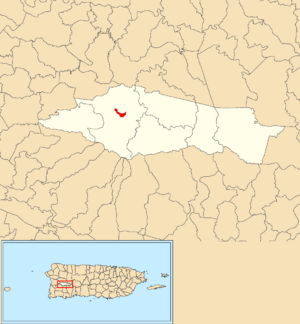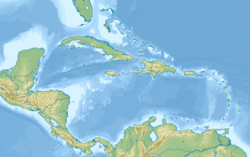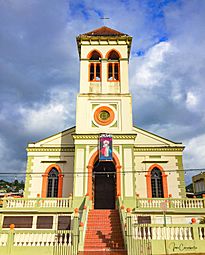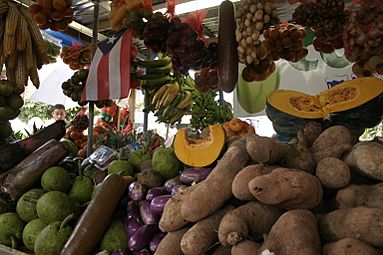Maricao barrio-pueblo facts for kids
Quick facts for kids
Maricao barrio-pueblo
Pueblo de Maricao
|
|
|---|---|
|
Municipality Seat
|
|

Fiesta del Acabe del Café in Maricao in 2014
|
|

Location of Maricao barrio-pueblo within the municipality of Maricao shown in red
|
|
| Commonwealth | |
| Municipality | |
| Area | |
| • Total | 0.11 sq mi (0.3 km2) |
| • Land | 0.11 sq mi (0.3 km2) |
| • Water | 0 sq mi (0 km2) |
| Elevation | 1,401 ft (427 m) |
| Population
(2010)
|
|
| • Total | 716 |
| • Density | 6,509.1/sq mi (2,513.2/km2) |
| Source: 2010 Census | |
| Time zone | UTC−4 (AST) |
Maricao barrio-pueblo is a special area in Maricao, a town in Puerto Rico. It's like the main downtown part of the town. This area is the "seat" or administrative center. This means it's where the town's government buildings are located. In 2010, about 716 people lived here.
Just like in Spain, towns in Puerto Rico often have a special area called a pueblo. This pueblo usually has a main square, also known as a central plaza. You'll also find the town hall and a Catholic church there. Every year, special celebrations called Fiestas patronales (which means "patron saint festivals") are held in this central plaza.
Contents
The Central Plaza and Its Church
The central plaza is a very important place. It's used for both official events and fun activities. People gather there to hang out and socialize from morning until night.
Back in the early 1800s, Spanish laws called the Laws of the Indies guided life in Puerto Rico. These laws said that the plaza should be a good place for "parties" or celebrations. They also said the plaza should be big enough for all the people living nearby. The laws even mentioned that the streets around the plaza should have comfortable walkways. These walkways would protect people from the sun and rain.
By 1864, there was a wooden church in Maricao pueblo. The church you see today, called Parroquia San Juan Bautista, was built between 1890 and 1898. It was later updated in 1960 and again in 1984.
History of Maricao Pueblo
After the Spanish–American War, Spain gave Puerto Rico to the United States. This happened because of an agreement called the Treaty of Paris of 1898. Puerto Rico then became a territory of the United States.
In 1899, the United States Department of War took a count of the people in Puerto Rico. This count, called a census, found that 1,179 people lived in Maricao Pueblo barrio at that time.
| Historical population | |||
|---|---|---|---|
| Census | Pop. | %± | |
| 1900 | 1,179 | — | |
| 1960 | 1,475 | — | |
| 1980 | 1,205 | — | |
| 1990 | 807 | −33.0% | |
| 2000 | 891 | 10.4% | |
| 2010 | 716 | −19.6% | |
| U.S. Decennial Census 1899 (shown as 1900) 1910-1930 1930-1950 1960 1980-2000 2010 |
|||
Festivals and Events
Maricao has one main yearly festival. It's called the End of the Coffee Harvest festival, or Acabe de Café. This festival celebrates the end of the coffee picking season. In the past, coffee farm owners would feed their workers to celebrate the harvest.
The festival happens every year in February, around President's Day weekend. It was started in 1977 by the mayor at the time, Vicente Byron. It has been a yearly tradition for over thirty years.
Gallery
See also
 In Spanish: Maricao (Maricao) para niños
In Spanish: Maricao (Maricao) para niños
- List of communities in Puerto Rico




